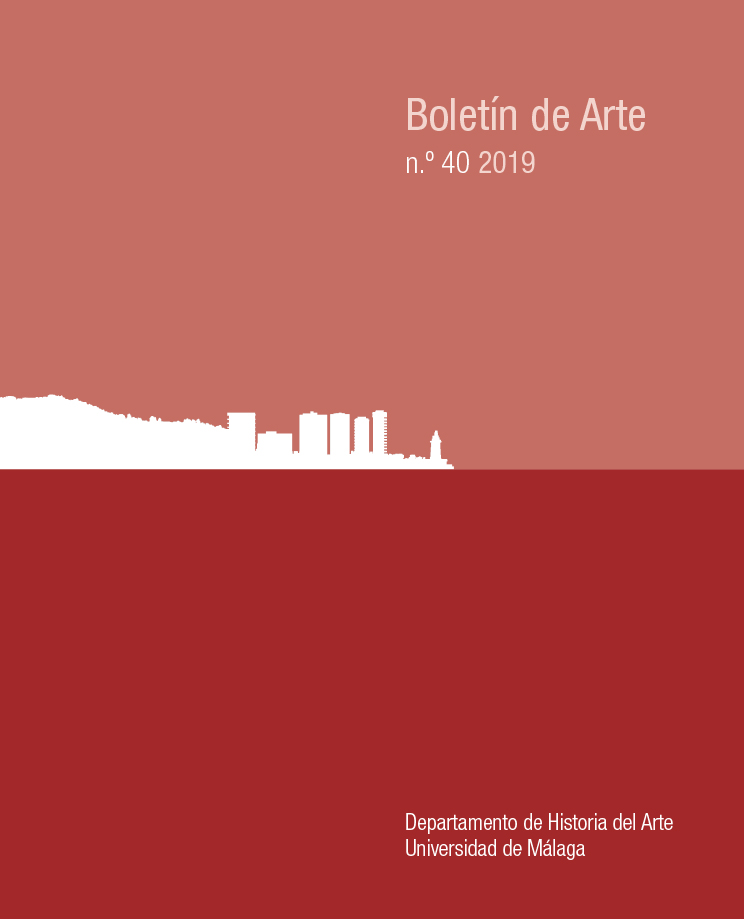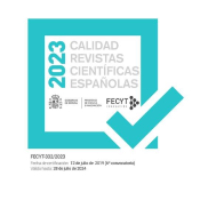¿Fedeltá o animalidad? El perro en las escenas de conversión de María Magdalena en la Italia del siglo XVI
DOI:
https://doi.org/10.24310/BoLArte.2019.v0i40.5689Resumen
Desde la Antigüedad, las distintas religiones han utilizado a los animales no humanos para encarnar los vicios y virtudes. El perro es uno de estos seres cuya carga simbólica se sitúa, según cada tradición, en el positivo o en el negativo. En este texto se estudia la presencia del perro en relación a la conversión de María Magdalena en representaciones de la Italia del siglo XVI, todo ello siguiendo los planteamientos propios de la iconografía e iconología así como la perspectiva de género.
Descargas
Métricas
Publicación Facts
Perfil de revisores N/D
Información adicional autores
Indexado: {$indexList}
-
Indexado en
- Sociedad Académica/Grupo
- N/D
- Editora:
- Universidad de Málaga.
Citas
BLOCK FRIEDMAN, John (2016), “Dogs in the Identity Formation and Moral Teaching Offered in some Fifteenth-Century Flemish Manuscript Miniatures”, en en GELFAND, Laura D. (ed.), Our Dogs, Our Selves. Dogs in Medieval and Early Modern Art, Literature, and Society, Brill, Leiden – Boston, pp. 325-362.
COHEN, Simone (2008), Animals as Disguised Symbols in Renaissance Art, Brill, Koninklijke.
DEMELLO, Margo (2012), Animals and Society: An Introduction to Human-Animal Studies, Columbia University Press, New York – Chichester – West Sussex.
HOBGOOD-OSTER, Laura (2008), Holy Dogs and Asses: Animals in the Christian Tradition, University of Illinois Press, Urbana – Chicago.
GARCÍA MAHÍQUES, Rafael (2009), Iconografía e Iconología. Volumen 2. Cuestiones de método, Encuentro, Madrid.
GROSS, Aaron (2012), “Introduction and Overview. Animals Others and Animal Studies”, en GROSS, Aaron y VALLELY, Anne (eds.), Animals and the Human Imagination. A Companion to Animals Studies, Columbia University Press, New York – Chichester – West Sussex, pp. 1-23.
GUINOT, Jean-Noël (2008), “La tradición patrística”, en VV.AA., Figuras de María Magdalena, Verbo Divino, Estella, pp. 15-50.
MANN, Judith W. (2016), “Federico Barocci’s Faithful Fidos: A Study in the Efficacy of Counter-Reformation Imagery”, en GELFAND, Laura D. (ed.), Our Dogs, Our Selves. Dogs in Medieval and Early Modern Art, Literature, and Society, Brill, Leiden – Boston, pp. 127-163.
MENACHE, Sophia (1997), “Dogs: God’s Worst Enemies?”, Society and Animals, vol. 5, nº. 1, pp. 23-44.
PANOFSKY, Erwin (1934). “Jan van Eyck’s Arnolfini Portrait”, The Burlington Magazine for Connoisseurs, vol. 64, N.º 372, Marzo, pp. 117-127.
SÁNCHEZ ORTEGA, María Helena (1992), “Woman as Source of ‘Evil’ in Counter-Reformation Spain”, en CRUZ, A.J. y PERRY, M. E. (eds.), Culture and Control in Counter-Reformation Spain, University of Minnesota Press, Minneapolis – Oxford, pp. 196-215.
SAX, Boria (2017), “Animals in Folklore”, en KALO, Linda (ed.), The Oxford Handbook of Animal Studies, Oxford University Press, New York, pp. 456-473.
SCHEICK, William J. (2005), “Animal Testimony in Renaissance Art. Angelic and other Supernatural Visitations”, en POLLOCK, M. y RAINWATER, C. (eds.), Figuring Animals: Essays on Animal Images on Art, Literature, Philosophy and Popular Culture, Palgrave MacMillan, s.l., pp. 65-79.
STEINER, Gary (2006), “Descartes, Christianity, and Contemporary Speciesism”, en WALDAY, P. y PATTON, Kimberly (eds.), A Communion of Subjects. Animals in Religion, Science, & Ethics, Columbia University Press, New York – Chichester – West Sussex, pp. 117-131.
WALKER-MEIKLE, Kathleen (2012), Medieval Pets, The Boydell Press, Woodbridge.
Descargas
Publicado
Cómo citar
Número
Sección
Licencia
Todos los contenidos publicados en la revista Boletín de Arte están sujetos a la licencia Creative Commons Reconocimento-NoComercia-Compartirigual 4.0 cuyo texto completo puede consultar en <http://creativecommons.org/licenses/by-nc-sa/4.0>

Los/as autores/as cuyas contribuciones sean aceptadas para su publicación en esta revista conservarán el derecho no exclusivo de utilizar sus contribuciones con fines académicos, de investigación y educativos, incluyendo el auto-archivo o depósito en repositorios de acceso abierto de cualquier tipo.
La edición electrónica de esta revista esta editada por la Editorial de la Universidad de Málaga (UmaEditorial), siendo necesario citar la procedencia en cualquier reproducción parcial o total.












4.png)
